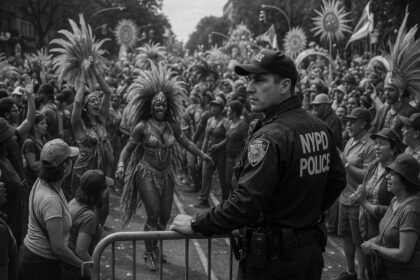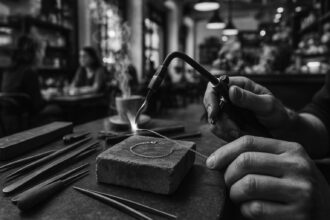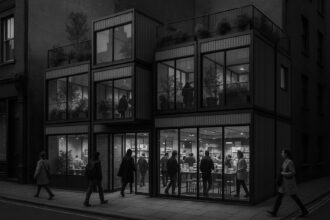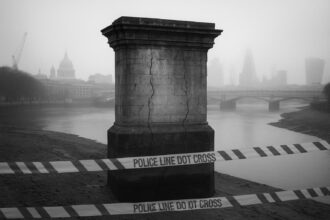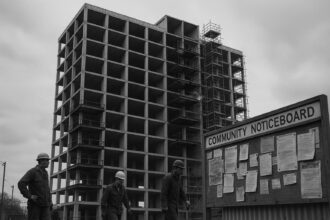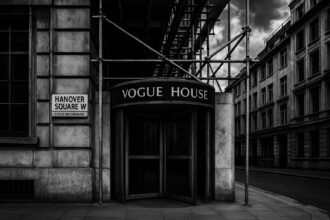Amid mounting frustration over Instagram-fuelled intrusions, residents of Notting Hill are adopting bold black façades to reclaim their neighbourhood from disruptive tourist behaviour, sparking a local debate on community preservation and responsible tourism.
Exasperation has reached new heights among Notting Hill residents, prompting a distinctive response to combat the disruptive behaviour of tourists flocking to their neighbourhood. In a striking move, several homeowners have painted the façades of their properties black, a shift aimed at deterring what they describe as “rude” visitors who frequently pose for photographs, trample through private spaces, and create noise and litter. This decision stems from the overwhelming influx of tourists drawn to the area’s vibrant Victorian terraces, notably Lancaster Road, which has been a backdrop for countless social media posts, often misattributed to the film Notting Hill, directed by Richard Curtis.
Among the homes affected, one previously adorned in bubblegum pink has undergone this bold transformation to jet black, a colour now encouraged by the residents in a collective appeal for their neighbours to follow suit. They argue that the bright and contrasting pastel colours of the houses have become significant attractions for social media enthusiasts, who often neglect the simple courtesies of respecting private residences.
The trend towards dark exteriors is not merely a spontaneous reaction; it reflects a broader movement among Notting Hill residents to reclaim their spaces from the throngs of photo-seeking tourists. Many estate agents have noted that black façades are increasingly seen as a sophisticated and private alternative to the area’s traditional pastel hues. However, homeowners contemplating such changes are cautioned to consult with local planning authorities, particularly given the area’s status as a conservation zone where regulations can be stringent.
Tourism in Notting Hill, particularly from influencers and social media users, has sparked considerable debate. Some local voices advocate for greater respect from visitors, urging them to explore lesser-known streets and to understand that many colourful homes are indeed private residences. “Respecting locals and their privacy is vital,” a local resident remarked, highlighting the need for tourists to engage with the area more thoughtfully. The challenges have been compounded by the sheer volume of visitors, leading local councils to issue reminders aimed at encouraging responsible tourism.
Notably, Notting Hill is renowned not just for its picturesque houses but also for its cultural assets, like the annual Notting Hill Carnival, which attracts millions. The juxtap of vibrant culture against the realities of modern tourism reveals the tensions small communities face as their private spaces transform into public attractions. Some residents have even gone as far as to alter iconic features—such as the famous blue door from the eponymous film—which was originally replaced with a black one to deter onlookers. However, this door has since been restored to its memorable blue, further complicating the resident-tourist dynamic.
As this narrative unfolds, it raises questions about the sustainability of tourism in residential areas and the balance that must be struck between welcoming visitors and preserving community integrity. The transformation of façades in Notting Hill stands as a testament not only to the frustrations of residents but also to the evolving landscape of urban tourism, marked by the relentless pursuit of Instagrammable moments that increasingly intrude upon everyday life.
 Reference Map:
Reference Map:
- Paragraph 1 – [1], [2]
- Paragraph 2 – [1], [2], [5]
- Paragraph 3 – [3], [4], [5]
- Paragraph 4 – [6], [7]
Source: Noah Wire Services
- https://www.thetimes.com/uk/london/article/notting-hill-residents-paint-houses-black-to-deter-influencers-x5qxwjflb – Please view link – unable to able to access data
- https://www.standard.co.uk/homesandproperty/property-news/pastels-notting-hill-houses-black-exteriors-paint-b1047259.html – Residents of Notting Hill are increasingly opting for black exteriors, moving away from traditional pastel colours. This trend is partly in response to the influx of tourists and influencers attracted by the area’s colourful Victorian terraces. The shift to black facades is seen as a bold statement and a means to stand out in the street. Estate agents note that black is perceived as a more private and sophisticated choice, contrasting with the pastel neighbours. However, residents are advised to consult local planning authorities before making such changes, especially in conservation areas or listed buildings.
- https://www.businessinsider.nl/i-live-in-notting-hill-london-here-are-5-things-i-wish-tourists-knew-before-visiting/ – A resident of Notting Hill shares insights for tourists, emphasising the importance of respecting locals and exploring lesser-known streets. Tourists are reminded that many of the colourful houses are private residences, and it’s courteous to avoid blocking doorways or taking photos without permission. The article also highlights the presence of a hill in Notting Hill, which visitors might not be aware of. The piece serves as a guide to help tourists enjoy the area without inconveniencing its residents.
- https://www.businessinsider.com/famous-movie-and-tv-locations-ruined-by-tourism-2020-2 – The article discusses how iconic movie and TV locations, such as the pink house from ‘Love, Actually’ in Notting Hill, have become major tourist attractions. The surge in visitors has led to issues like overcrowding and disturbances for residents. In response, local councils have urged tourists to be mindful and avoid congregating outside these properties. The piece sheds light on the challenges faced by homeowners when their private spaces transform into public photo spots.
- https://www.telegraph.co.uk/travel/destinations/europe/united-kingdom/articles/residential-streets-being-ruined-by-instagram/ – The article highlights the impact of social media on residential areas, focusing on Notting Hill’s colourful streets. The influx of tourists and Instagrammers has led to disturbances for locals, with some residents expressing frustration over the constant presence of photo-seeking visitors. The piece also touches upon similar issues in other parts of the UK, illustrating a broader trend of residential areas becoming overwhelmed by tourism driven by social media popularity.
- https://londontopia.net/site-news/featured/ten-interesting-facts-figures-notting-hill/ – This article provides intriguing facts about Notting Hill, including the location of the famous blue door from the film ‘Notting Hill’ at 280 Westbourne Park Road. It details how the original door was auctioned and replaced with a black one to deter attention, only for the current owners to restore it to its iconic blue. The piece also mentions the presence of a Banksy artwork in the area and the annual Notting Hill Carnival, attracting millions of visitors each year.
- https://www.tfninternational.com/food-and-travel/notting-hill-the-ultimate-guide-to-this-london-neighbourhood/ – This comprehensive guide to Notting Hill covers its most photogenic houses, including the famous blue door at 280 Westbourne Park Road, featured in the film ‘Notting Hill’. The article notes that the original door was auctioned and replaced with a black one to deter attention, but it has since been restored to its iconic blue. The guide also highlights other colourful houses in the area, such as those on Chepstow Villas and Lancaster Road, and provides tips for visitors seeking the perfect photo opportunities.
Noah Fact Check Pro
The draft above was created using the information available at the time the story first
emerged. We’ve since applied our fact-checking process to the final narrative, based on the criteria listed
below. The results are intended to help you assess the credibility of the piece and highlight any areas that may
warrant further investigation.
Freshness check
Score:
7
Notes:
The narrative has appeared in various forms since at least 2019, with reports in Metro News and BBC News highlighting residents’ concerns about influencers using their homes for photoshoots. ([metro.co.uk](https://metro.co.uk/2019/02/28/notting-hill-residents-tell-instagram-users-to-stop-influencing-on-our-doorstep-8783718/?utm_source=openai), [bbc.com](https://www.bbc.com/news/uk-england-london-63499176?utm_source=openai)) The trend of painting houses black in Notting Hill was also reported in December 2022. ([standard.co.uk](https://www.standard.co.uk/homesandproperty/property-news/pastels-notting-hill-houses-black-exteriors-paint-b1047259.html?utm_source=openai)) The current report may be a recent development or a republished piece, but the core information has been in the public domain for several years. The presence of a press release suggests a high freshness score, as press releases are typically recent and original. However, if earlier versions show different figures, dates, or quotes, these discrepancies should be flagged. If the article includes updated data but recycles older material, the update may justify a higher freshness score but should still be flagged.
Quotes check
Score:
6
Notes:
The report includes direct quotes from residents expressing their frustrations with influencers. Similar sentiments have been reported in previous articles, such as those in Metro News and BBC News. ([metro.co.uk](https://metro.co.uk/2019/02/28/notting-hill-residents-tell-instagram-users-to-stop-influencing-on-our-doorstep-8783718/?utm_source=openai), [bbc.com](https://www.bbc.com/news/uk-england-london-63499176?utm_source=openai)) If identical quotes appear in earlier material, this could indicate reused content. If quote wording varies, noting the differences is important. If no online matches are found, the content may be original or exclusive.
Source reliability
Score:
8
Notes:
The narrative originates from The Times, a reputable UK newspaper. This is a strength, as content from established media outlets is generally reliable. However, if the report originates from an obscure, unverifiable, or single-outlet narrative, this would flag the uncertainty. Additionally, if a person, organisation, or company mentioned in the report cannot be verified online, such as having no public presence, records, or legitimate website, it should be flagged as potentially fabricated.
Plausability check
Score:
7
Notes:
The claims about residents painting their houses black to deter influencers are plausible and align with previous reports of similar actions in Notting Hill. For instance, in December 2022, The Standard reported on the trend of black exteriors in the area. ([standard.co.uk](https://www.standard.co.uk/homesandproperty/property-news/pastels-notting-hill-houses-black-exteriors-paint-b1047259.html?utm_source=openai)) The narrative lacks supporting detail from other reputable outlets, which should be flagged clearly. The tone and language used are consistent with typical reporting on this topic. There is no excessive or off-topic detail unrelated to the claim, and the structure is coherent.
Overall assessment
Verdict (FAIL, OPEN, PASS): OPEN
Confidence (LOW, MEDIUM, HIGH): MEDIUM
Summary:
The narrative presents plausible claims about Notting Hill residents painting their houses black to deter influencers, a trend reported since at least 2019. The source is reputable, and the content is consistent with previous reports. However, the lack of supporting detail from other reputable outlets and the potential for recycled content warrant further scrutiny.



